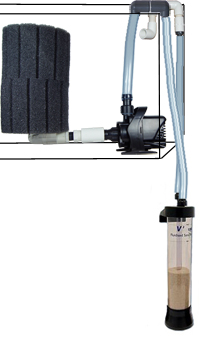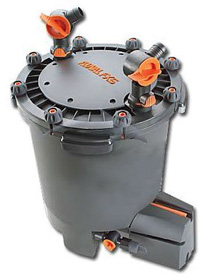Canister Filters have been around for many years, long before I got my start professionally (working for an aquarium service company in 1986).
Eheims, Fluvals, Marineland Magnums, Rena Filstar, are just a few of the brands I have and still use.
Unfortunately these filters can occasionally be a nightmare in priming or loosing their prime due to connections, air bubbles, etc.
I managed these problems well since a leaky filter is something my clients pay me to NOT have.
However I also get many calls (as did my previous employer) from non-clients who request one time service calls for canister filters purchased elsewhere that they simply cannot get started or re-started.
This brings me to the point of this review; while canister filters are awesome for their capacity (assuming proper set up), these filters often can be be nitrate factories for high bio load fresh & saltwater aquariums.
As well, these filters are easily the number one cause of aquarium “headaches” based on my experiences with regular clients and one time service call customers.
One of the problems (among many) is the motor on the top which often gets an air bubble in the impeller well resulting in the filter stopping.
The Fluval FX5 addressed this problem with a bottom/side pump, which is by far the main improvement this filter offers in my experience (I emphasize experience, not just opinion).
The Fluval FX5 has many other features as well including what Hagen (the manufacturers) calls “Smart Pump™ Technology”. Personally I find this feature more of a gimmick as well as most of the other so-called features which are not much more than any other canister filter, except this filter retails generally for over $300 compared to much less for otherwise comparable filters.
As with ALL other canister filters, changing this filter is often a chore, despite some of the claimed “new features”.
 This brings me to my comparison with a Fluidized Sand Bed Aquarium Filter.
This brings me to my comparison with a Fluidized Sand Bed Aquarium Filter.
These filters when properly set up (also assuming manufacturer) have a bio capacity that the Fluval FX5 or any other canister filter simply CANNOT match.
As well the simplicity is mind boggling when compared with ANY canister filter, since the filter is essentially self cleaning due to the abrasive action of the the sand in liquid suspension.
These filters also beat a wet/dry filter hands down on bio capacity and for planted freshwater aquariums are a no brainer when compared to a wet/dry since these do not “scrub” CO2 nearly as much as a wet/dry filter can and does do.
Part of the problem these filters have not “taken off” in my opinion is the fact that the aquarium hobby is very anecdotal and unwilling to think outside the box much of the time. This includes how to set up a Fluidized filter.
The picture to the above left displays a top of the line TMC V2 1000 Fluidized Filter mated to a water pump (SunSun JBQ 3500), then a Hydro Pond Sponge Filter attached to it. The Hydro Pond #4 by its own rights can handle an aquarium over 100 gallons, so when added to a Fluidized Filter that can handle 20 lbs of fish bio load (this is a lot of fish for an average aquarium under 200 gallons), you have a filter system second to none.
The negative of this set up is the large and sometimes obtrusive Hydro Pond #4, for which I generally prefer the vastly smaller Filter Max Pre-Sponge Filters (4 inches by 2.75 inches).
The other somewhat negative is the general lack of chemical filtration, however this is easily overcome by placing filter saver nylon bags of your favorite chemical media (such as carbon) behind the sponge pre-filter in the area of highest flow.
As well the use of products such as NPX Bio Plastics can be added directly to the Fluidized Sand Bed Filter which then aids in nitrate and Phosphate removal.
So you can see this second negative really is not a negative.
Back to positive, the ease of rinsing the sponge filter is so much easier than the cumbersome task of opening up a canister filter, and changing a small nylon chemical filter bag (if needed) is simple as well.
As to the Fluidized Bed Aquarium Filter itself, I have many types and have found TMCs V2 Fluidised Sand Bed Aquarium Filter by far the best due to the excellent fluidation and ease of adding additional sand or other media (this is where the popular Lifeguard model fails in my experience).
The other feature I like about the TMC over other designs is the ability to add Oolitic Fluidation sand which during its action in the chamber aids in buffering water for essential mineral cations and pH; this is a major plus for Liverbearer fish, African Cichlids, and of course any saltwater fish or reef tank, often taking the place of a Calcium Reactor when calcium needs are low to moderate.
The final feature I like is, as noted earlier, the use in planted freshwater tanks (using standard silica media) where this filter does not strip CO2 the way many other Hang on or canister filters can do. This makes this the filter of choice for any planted freshwater aquarium.
In summary; while the expensive Fluval FX5 is an improvement over older Fluvals and some other canister filters, for my money it is an over priced piece of equipment that is more than 50% more than a Fluidized Filter, Pump, and Filter Max Pre-Filter combination that can easily out perform it, all the while being a simpler filter system to maintain.
